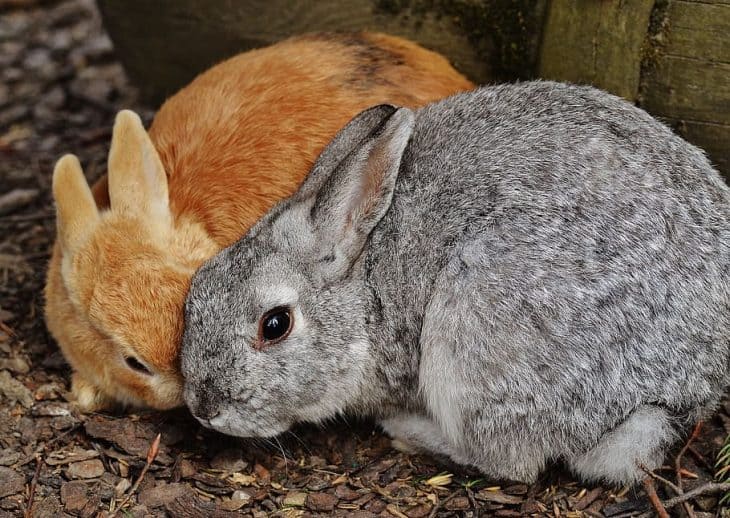
“Rabbit”, “hare”, “bunny”. These are all terms that are often used interchangeably, which leads to a common misconception that rabbits and hares are the same animal. To make matters worse, this confusion is confounded by the common names of many species of rabbits and hares. For instance, the Jackrabbit, despite its name, is actually a species of hare. On the other side of the spectrum, the hispid hare, red hock hare, and Belgian hare are all actually breeds of rabbits. So the big question is, Hare vs Rabbit, what’s the difference?
In reality, however, although rabbits and hares are both mammals in the family Leporidae, they are, in fact, entirely different species from one another. Continue reading to find out exactly how to differentiate between these two woodland animals.
Hare vs. Rabbit: Physical Appearance

To the untrained eye, hares and rabbits look extremely similar. They have small furry bodies, long floppy ears, fluffy tails, and strong hind legs. If you keep your eyes peeled, however, you’ll see that there are small but recognizable physical differences between a hare vs rabbit.
Firstly, hares are generally bigger than rabbits. The common European rabbit grows up to about 16 inches and can weigh up to 3 to 4 pounds. The adult brown hare, or European hare, can grow up to 29 inches, and usually weighs around 7 pounds to 11 pounds. The larger sizes of hares mean that they also tend to have much longer ears and larger, stronger hind legs.
A hare vs rabbit also differs in terms of the color of their fur. Although both species go through molting, the fur of a rabbit tends to stay the same color throughout the year, with very little variation in color. Hares, however, can undergo drastic changes in fur color throughout the seasons. The snowshoe hare, for instance, is also known as the varying hare. This is because, in order to better camouflage itself, the snowshoe hare transitions from white fur in the winter to rusty brown in spring and summer.
Hare vs. Rabbit: Life History
The life history of an animal refers, broadly, to its typical cycle of reproduction and mortality. Although hares and rabbits are both known for being extremely fertile, there are distinct differences in their reproductive cycles and developmental stages.
Reproductive Cycle
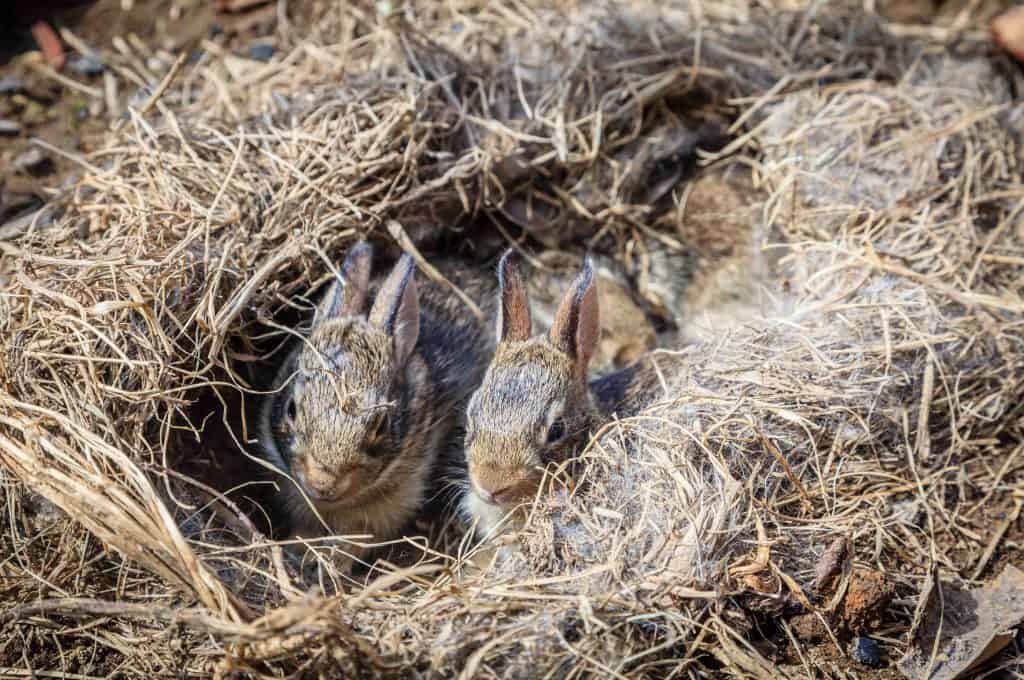
One similarity hares and rabbits share with regards to their reproductive cycle is their breeding seasons. Both species of mammals breed in March. This is likely what gives rise to the figure of speech “mad as a March hare”, a reference to how hares have been known to go especially wild during mating season. Common behaviors for hares during mating season include leaping into the air, and female hares boxing males that are chasing them if they are not yet ready to mate.
One difference between hares vs rabbits is that European hares have been proven to exhibit superfoetation. In other words, a pregnant European hare can actually become pregnant again, a fact which likely adds to the myth of the fertile hare. The conflation of hares and rabbits have led people to claim that rabbits are also capable of the same feat. However, superfoetation has not actually been observed in rabbits.
Rabbits and hares also differ in terms of the length of their gestation periods and their litter sizes. Rabbits tend to gestate for 30 to 32 days, and the size of their litter ranges from anywhere above four and below twelve. Hares, on the other hand, have slightly a longer gestation period, at roughly 45 days. Their litters also tend to be much smaller, as hares rarely have more than six in a litter.
Development at Birth
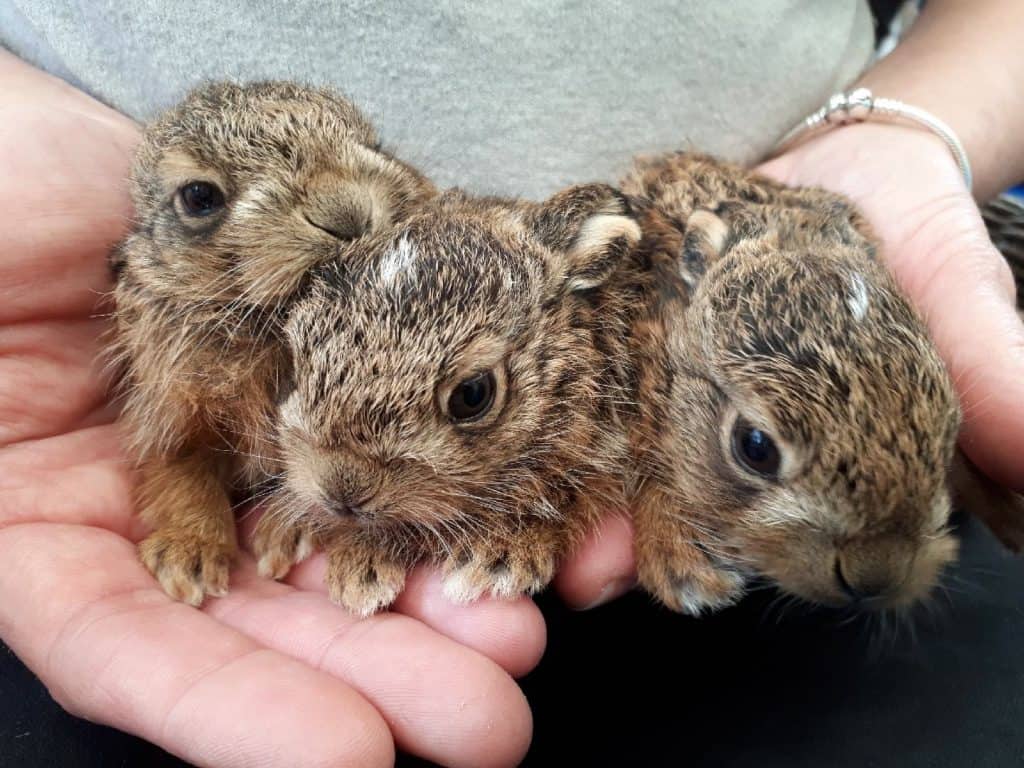
Baby hares and rabbits have extremely different developmental periods. Baby hares, or leverets, are born fully developed and much hardier at the outset. Leverets are born with fur and have the ability to hop and run within just a few minutes of birth.
In contrast, baby rabbits, also known as kittens or kits, are born underdeveloped. In terms of their physical appearance, they are born furless and blind. Kittens only grow fur within the first week of their birth, and are only able to see by the second or third week.
Hare vs. Rabbit: Temperament and Behavior
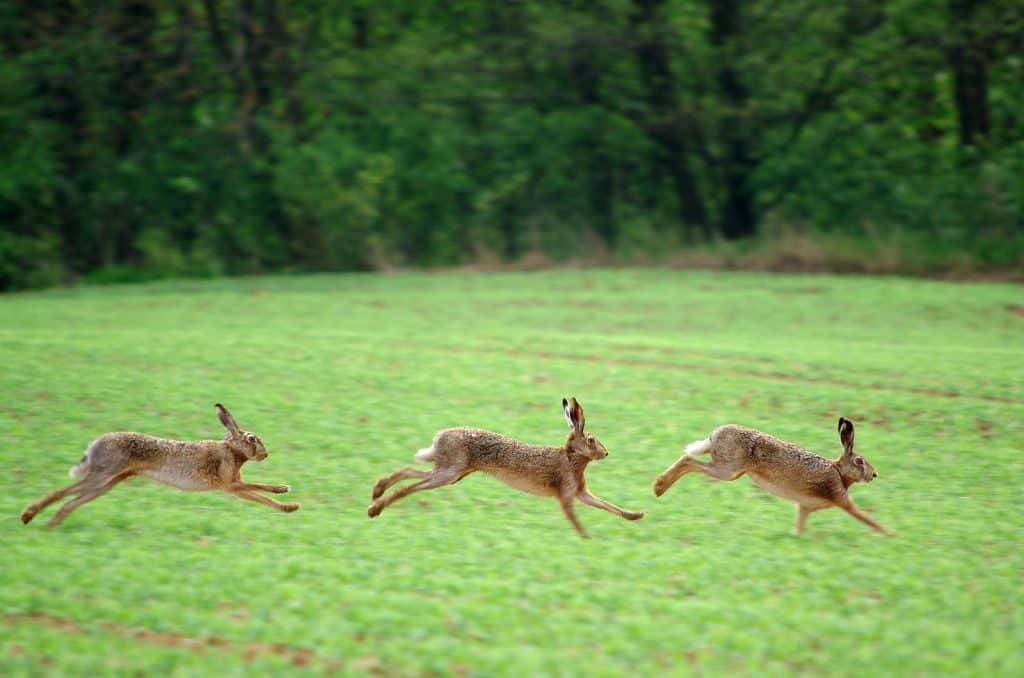
There is a common perception that rabbits are timid, easily frightened creatures. In reality, however, hares are even more skittish than rabbits are. Hares are extremely nervous animals, prone to running away at the first sign of danger. This is likely where the word ‘hare-brained’, which describes rash or reckless behavior, comes from. Rabbits, in contrast, are more likely to hide than to run. This is likely due to their weaker hind legs, which means they run much more slowly than hares do.
Hares are also known to be solitary creatures, preferring to travel either in pairs or by themselves. In comparison, rabbits are much more social animals, living in colonies of up to twenty rabbits. This social temperament is likely why rabbits are much more popular as domestic pets, as opposed to hares which have not yet been domesticated. However, the eastern cottontail rabbit is one exception to this, as it is a rare species of rabbit that prefers solitary living.
One final difference between hares vs rabbits is that hares are nocturnal, while rabbits are crepuscular. This means that hares tend to be more active at night, since their larger sizes allow them to stay warmer in cooler temperatures. Rabbits, on the other hand, are active during the twilight period, during the daytime till dusk.
Hare vs. Rabbit: Habitat
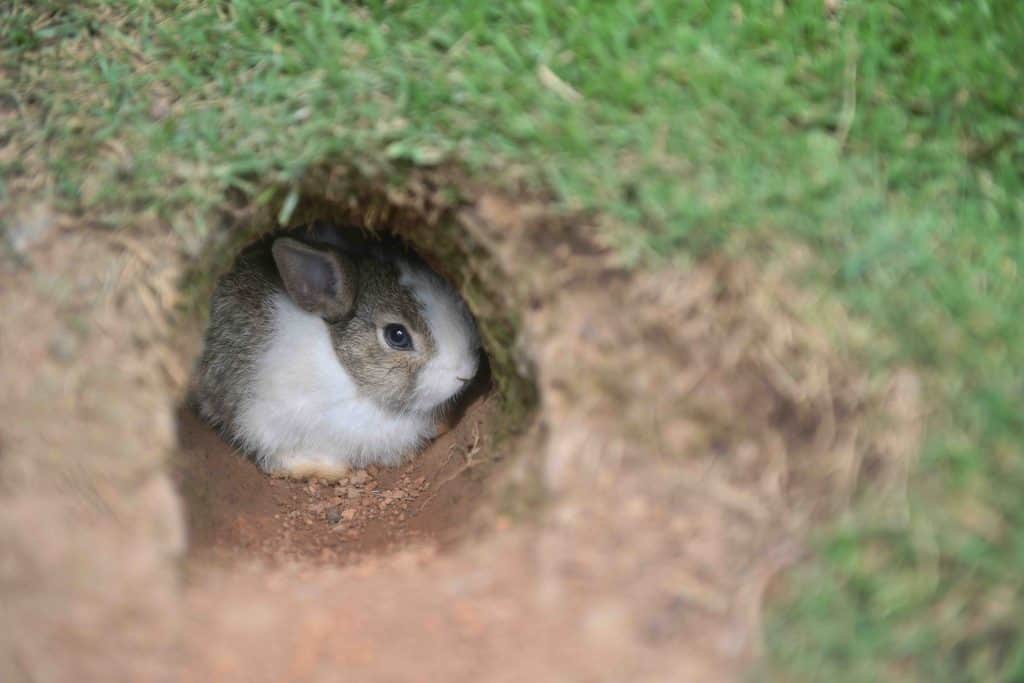
One of the easiest ways to tell the difference between a hare vs rabbit is to see: where do they live? Rabbits tend to prefer areas with plenty of cover. They will dig underground to build complex burrows or warrens to reside and reproduce in. Hares, on the other hand, live completely aboveground, in wide-open spaces. They prefer to make nests in the grass or in hollow logs. This allows them to run away quickly at the first sign of the predator.
There are, however, exceptions to the burrowing rabbits. The cottontail rabbit is one species of rabbit that does not dig burrows.
Hare vs. Rabbit: Diet
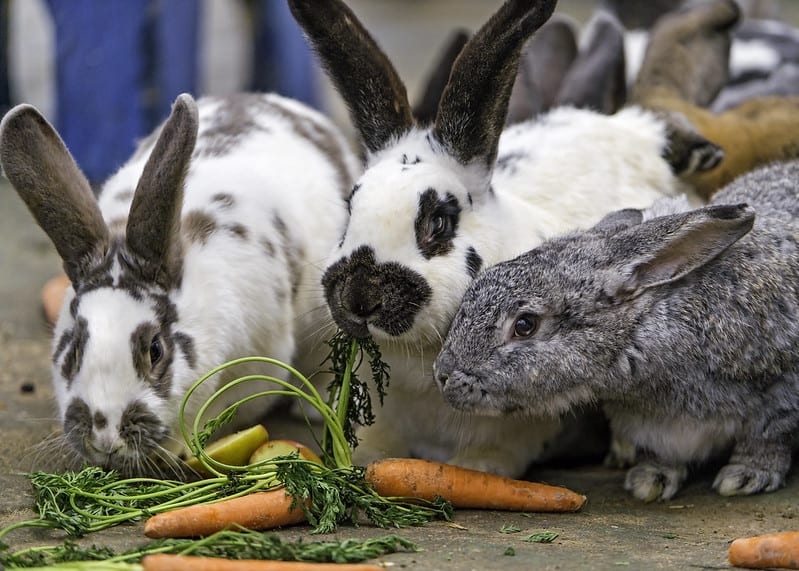
An extremely common image of the rabbit or hare in the media is of the cute, furry creature chewing on grass or carrots. This has led to a general belief that rabbits and hares are herbivores, which means they only eat plants. In reality, however, this belief is somewhat erroneous.
It is true that both rabbits and hares consume plants, but the types of plants they consume are slightly different. Rabbits tend to prefer softer foods, such as tender leaves, grasses, or vegetables with leafy tops like carrots. Hares, however, consume woodier materials such as bark and plant shoots.
Furthermore, while rabbits are exclusively herbivorous, some species of hare are actually carnivorous. For example, the snowshoe hare, which resides in cold climates, has been known to scavenge for meat to stay warm.
Is The Easter Bunny a Rabbit or Hare?
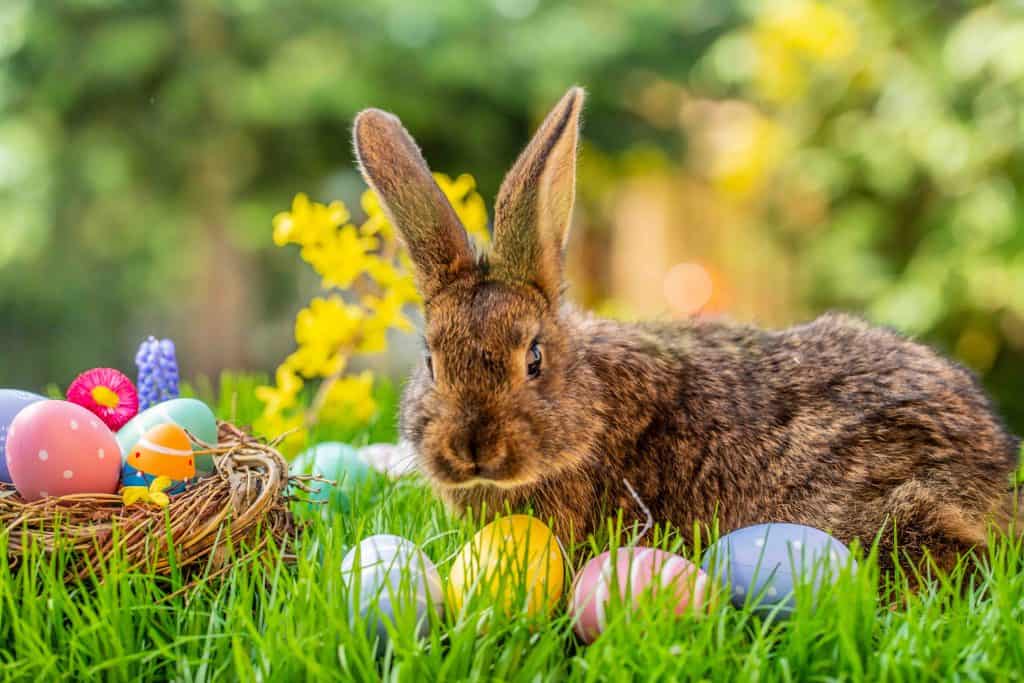
Now that we’ve listed all the differences between a hare vs rabbit, one might ask: is the folkloric Easter Bunny a rabbit, or a hare? The answer is a surprisingly easy one: it is a rabbit. Historical depictions of the Easter Bunny show that it was likely first recorded as a white hare, with long ears and hind legs. Modern pictures of the Easter Bunny, however, depict a shorter-eared animal with shorter animals, suggesting that at some point, the Easter Bunny transitioned into becoming an Easter Rabbit.
So there you have it, the differences between hares and rabbits revealed. The next time you encounter a bunny in the wild, take a moment to observe it and you’ll just be able to tell which member of the Leoporidae family it is.
- Common European rabbits grow up to about 16 inches and can weigh up to 3 to 4 pounds.
- An adult brown hare can grow up to 29 inches, and usually weighs around 7 pounds to 11 pounds.
- Rabbits reside in areas with plenty of cover and will dig underground to build complex burrows or warrens.
- Hares live completely aboveground in wide-open spaces, and prefer to make nests in the grass or in hollow logs.
- A rabbit’s litter ranges from anywhere above four and below twelve, while a hare’s litter tends to be much smaller, rarely having more than six.
- Rabbit and hares are both mammals of entirely different species in the family, Leporidae.
- They are impossible to crossbreed together because they are genetically incompatible.
- Both species breed during March.
- A common behavior for hares during mating season includes leaping into the air.
- Some species of hare are actually carnivorous, such as the snowshoe hare, which resides in cold climates and is known to scavenge for meat to stay warm.
- Rabbits prefer softer foods, such as tender leaves, grasses, or vegetables with leafy tops like carrots.
- Baby hares are called leverets, while baby rabbits are called kittens.
- Baby rabbits are born furless and blind.
- Hares are known to be solitary creatures, preferring to travel either in pairs or by themselves.
- Rabbits are much more social animals, living in colonies of up to twenty rabbits.
- Hares are nocturnal, while rabbits are active during twilight.
- The figure of speech “mad as a March hare” is a reference to how hares tend to go wild during mating season.
- A rabbit’s fur tends to stay the same color throughout the year, with very little variation in color.
- Hares can undergo drastic changes in fur color throughout the seasons.
- You cannot look for a hare in a pet shop because these are not domesticated animals compared to their rabbit counterpart.
Was this page helpful?
Our commitment to delivering trustworthy and engaging content is at the heart of what we do. Each fact on our site is contributed by real users like you, bringing a wealth of diverse insights and information. To ensure the highest standards of accuracy and reliability, our dedicated editors meticulously review each submission. This process guarantees that the facts we share are not only fascinating but also credible. Trust in our commitment to quality and authenticity as you explore and learn with us.
